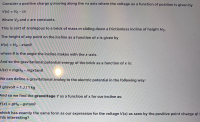Question
Disussion electric potential and gravitational potential


Transcribed Image Text:1. Estimate or measure the height (in m) above ground level of some location in your environment. It can be the
top of your head, the top of your desk, the height of a doorknob, etc. Calculate and state the gravoltage (in
J/kg) associated with the Jocation you have chnsen
Expert Solution
This question has been solved!
Explore an expertly crafted, step-by-step solution for a thorough understanding of key concepts.
This is a popular solution
Trending nowThis is a popular solution!
Step by stepSolved in 2 steps with 1 images

Knowledge Booster
Similar questions
- The statement “if the electric field does positive work on a charge, the potential energy of the system decreases” is true if The charge is either positive or negative The charge is negative The charge is positive No answer (the statement is false)arrow_forward(Mulitple choice) If we move a negatively charged particle through an electric field, in which situation is there no change in the electric potential energy of the particle? (explain why that answer is correct) a. We move the particle in the direction of the electric field b. We move the particle in the direction opposite that of the electric field c. We move the particle perpendicularly to the direction of the electric fieldarrow_forwardPart i, ii and iiiarrow_forward
- Calculate the electric potential energy of the following arrangement of charges: A 3.2 C charge is placed at (4,0)m, a -5.7 C charge is placed at (0,3) m, and a 3.5 C charge is placed at -4, -3) m.arrow_forwardQuestion in the picturearrow_forwardCalculate the work done to move a positively charged particle of 2.5 x 10-18 C a distance of 3.0mm towards a positive plate in a uniform electric field of 556 NC-¹. A particular electron gun accelerates an electron a distance of 12 cm between a pair of charged plates across a potential difference of 15 kV. What is the magnitude of the force acting on the electron? (Use %=-1.6 x 10-¹9 C.)arrow_forward
arrow_back_ios
arrow_forward_ios